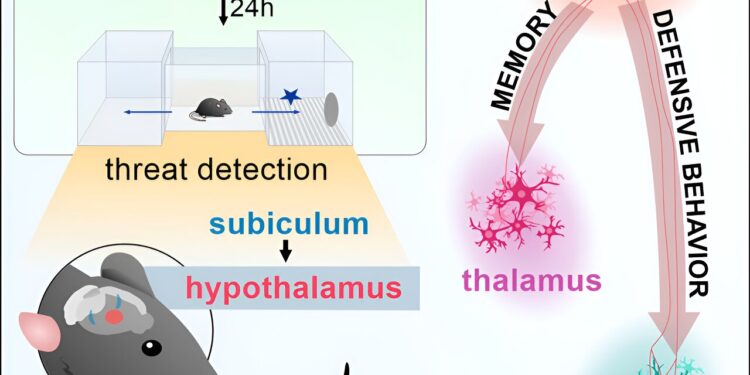Graphic summary. Credit: Current Biology (2024). DOI: 10.1016/j.cub.2024.05.006
An article published in the journal Current Biology describes experiments that mapped a brain circuit responsible for instantly detecting threats and forming fear memories.
“We wanted to locate a brain region associated with fear signaling and see how it could identify environments previously associated with physical or predatory threats, such as a place where the individual experienced an aversive physical stimulus,” said Newton Sabino Canteras, a full professor in the Department of Anatomy at the University of São Paulo’s Institute of Biomedical Sciences (ICB-USP) in Brazil and last author of the paper.
The hippocampus is known to be involved in spatial navigation and orientation. This region of the brain also detects threats in the environment. Anything dangerous leaves a trace in this area, which helps calculate the precise location of the threat, Canteras explains. A key structure closely related to the hippocampus is the subiculum.
“The subiculum is kind of the star of the show. It transfers information related to environmental threats to the hypothalamus. We wanted to study how it behaves when the animal faces an environment previously associated with an aversive stimulus,” he said.
The researchers used fiber optic photometry to observe the activity of the subiculum. “We inserted a virus that expresses a calcium-sensitive protein that can record cellular activity. It fluoresces in response to cellular activity,” Canteras explained.
The behavioral paradigm used consisted of habituating a mouse to a device consisting of two boxes connected by a corridor. At first, the mouse was confined to a single box and received aversive physical stimuli (electric shocks to its feet). The next day, it was placed in the device so that it could avoid the aversive box.
“In this type of test, the animal stretches and sniffs, moves back and forth, but does not return to the box where its feet were shocked. It exhibits what is called avoidance behavior,” he explained.
Photometric analysis focused on the dorsal premammillary nucleus (PMd), a critical interface of the neural circuit studied, showed that the PMd becomes particularly active when the animal approaches and avoids the threatening source.
“It’s a very clear threat detector and it interacts dynamically with the source. If the mouse turns its back to the source, the PMd is not activated, but if it looks at the source or approaches it, the PMd ‘triggers the alarm’. That’s one of the key findings of the study,” he said.
The researchers then inactivated PMd with a widely used chemogenetic technique known as DREADD, short for designer receptors activated exclusively by designer drugs.
“We injected a virus that expressed a receptor (the hM4Di protein) that silenced PMd in the presence of a specific drug. The drug stopped the cells from activating. They resumed normal functioning as soon as the drug was removed.
“When the PMd was silenced in this way, the animal significantly reduced its defensive response. Instead of avoiding the threatening box, it returned to it as if it were a harmless environment, as if nothing had happened,” he said.
They concluded that PMd inactivation influenced both contextual fear responses and fear memory reconsolidation. Thus, after PMd inactivation, the animal viewed the environment as safe and navigated it as if there were no risk the next day.
They then studied the functional roles of the main targets of PMd in the nervous system: the periaqueductal gray or PAG (in the brainstem) and the ventral anteromedial thalamus (in the thalamus).
“There is a technique that allows me to specifically inactivate the projection that goes to the brainstem or to the thalamus. I insert into the PMd a virus that expresses a protein that acts as a light-sensitive chlorine channel. When I turn on the terminal fields, these terminals are silenced and I can manipulate a specific projection pathway,” Canteras explains.
The researchers observed that although inactivating the PAG projection pathway reduced the animal’s defensive behavior, it responded well to fear the following day, showing that fear memory was not affected.
“Behavioral expression is affected, but not fear memory reconsolidation. In contrast, inactivation of the thalamus pathway has virtually no immediate effect but significantly affects fear memory reconsolidation,” he said, adding that the two events are primarily mediated by different nucleus projection sites.
The article’s co-first authors are Juliette Viellard (ICB-USP and Institute of Neurodegenerative Diseases, University of Bordeaux, France), and Fernando Melleu (ICB-USP).
Other co-authors are Alicia Tamais, Alisson de Almeida, Carolina Zerbini, Juliane Ikebara, Karolina Domingues, Miguel de Lima, Simone Motta (all ICB-USP); and Fernando A. Oliveira (Cellular and Molecular Laboratory, Center for Mathematics, Computation and Cognition, Federal University of ABC).
More information:
Juliette MA Viellard et al, A subiculum-hypothalamic pathway functions in dynamic threat detection and memory updating, Current Biology (2024). DOI: 10.1016/j.cub.2024.05.006
Quote:Researchers map brain circuits that signal immediate danger and create memories to help avoid threats (2024, August 22) retrieved August 22, 2024 from
This document is subject to copyright. Apart from any fair dealing for the purpose of private study or research, no part may be reproduced without written permission. The content is provided for informational purposes only.



